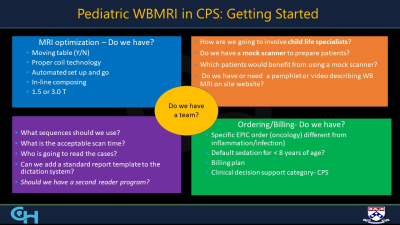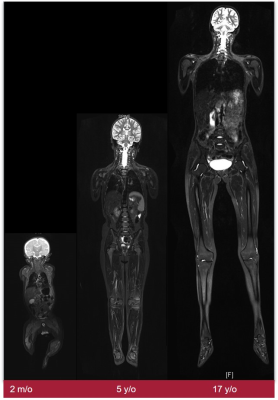Weekend Course
Pediatric Multiorgan Diseases
Joint Annual Meeting ISMRM-ESMRMB & ISMRT 31st Annual Meeting • 07-12 May 2022 • London, UK

| Cancer Predisposition Syndromes I | |||
| 12:30 | Cost-Effectiveness in Screening of Pediatric & Adult Cancers in Li-Fraumeni Syndrome
Maria Isabel Achatz, Isadora Frankenthal, Mariana Cartaxo Alves, Casey Tak
Li-Fraumeni Syndrome (LFS) predisposes to multiple pediatric and early-onset adult cancers. Its underlying cause is a germline pathogenic variant in TP53 gene. In Brazil, there is a higher prevalence of LFS due to the founder mutation, p.R337H. However, a large portion of the population does not have access to effective screening that enables early diagnosis and improves overall survival. The main strategy in LFS screening is an annual Rapid Whole-Body MRI at diagnosis, from birth. We assessed cost-effectiveness of annual screening for patients diagnosed with LFS in Brazil.
|
||
| 12:50 | Role of Whole-Body MRI in Pediatric Cancer Predisposition Syndromes
Martin Kyncl, Michal Zapotocky, David Sumerauer
With the advances in genetic testing, more children are being diagnosed with cancer predisposition syndromes. Patients with these syndromes are at increased risk of developing malignancies. Whole-body MRI is a powerful and radiation-free imaging modality for the detection of pathologies in multiple organs with wide anatomical coverage. There is no established consensus for a standardized pediatric MRI protocol that provides high diagnostic accuracy while achieving time efficiency. We provide a reflection on the protocols suitable for MRI imaging in children with cancer predisposition syndromes at present, the necessary anatomical coverage, the types of sequences, the incorporation of dedicated imaging protocols.
|
||
| 13:10 | Whole-Body MRI Screening in Australian Patients with Li-Fraumeni Syndrome
David Thomas
|
||
| Cancer Predisposition Syndromes II | |||
| 13:30 |  |
Pediatric WBMRI in CPS: Getting Started
Lisa States
This talk will review the evolving development of whole-body imaging protocols for pediatric patients with a known germline mutation. Harmonization of protocols and performance of clinical studies of focused on syndromes with cancer predisposition remain the most important initiatives in caring for this population. The challenges of tumor surveillance will also be addressed. The benefit of whole-body MRI in the pediatric population is clear with the most important factors being lack of ionizing radiation and early cancer detection potentially leading to aggressive treatment and greater chance for a cure.
|
|
| 14:00 |  |
Pediatric WBMRI in CPS: Case-Based Learning
Jürgen Schäfer
Approximately 10% of children and adolescents with cancer have an underlying CPS. Patients with CPS have an increased lifetime risk for a specific tumor. In addition to indications for imaging in cases of clinical suspicion, planned screenings to exclude clinical occult tumor manifestation are essential. Due to the increased sensitivity in CPS to ionizing radiation, MRI is favored. WB-MRI employs fluid-sensitive fat-suppressed 2D sequences as a baseline but must be supplemented with high-quality organ examination in cases of suspicious findings or high-risk constellations. With the latest techniques, such as compressed sensing, the very time-consuming measurements can be considerably shortened.
|
|
| 14:30 | Break & Meet the Teachers |
||
| Inflammatory Bowel Disease I | |||
| 14:50 | The Truth Is in the Numbers: Epidemiology, Health Equity & Access in the Pediatric-Onset IBD Pandemic
Almuthe Hauer
Annual incidences of (Pediatric) Inflammatory bowel diseases (P-IBDs) - traditionally "diseases of westernised nations" - increase steadily in newly industrialised countries, but (P)IBD management is known to be substantially impaired in low and middle-income countries without structured health-care and (P)IBD experts. Current guidelines on PIBD management focus on high income countries, and include imaging as mandatory diagnostics. However, the choice of modality depends on local structures: MRE, preferred for CD diagnosis, is mostly inaccessible, and Small bowel follow through problematic (high radiation exposure). In this context, intestinal ultrasound is thus the primary imaging modality, considering good performance, wide availability and low costs.
|
||
| 15:10 | MR Enterography Interpretation in IBD & Alternate Diagnoses
Sudha Anupindi
MR enterography is the main imaging modality for the assessment of inflammatory bowel disease in children. In this session we will discuss a methodical approach to interpretation of these studies. Although this approach is often a qualitative assessment of intramural and extramural pathology, a quantitative assessment can be used. Reporting MRE studies using a standard template utilizing current nomenclature to provide key findings of active inflammation, associated complications and determination of response to treatment is essential. MRE can be utilized to assess other bowel pathologies such as polyps, infectious colitis and graft-versus -host disease.
|
||
| 15:30 |  |
Role of MR Imaging of Perianal Involvement in Pediatric & Adult Crohn Disease
Anuradha Shenoy-Bhangle
Pelvic MRI is the standard of care in imaging perianal fistulae in patients with Crohn disease. Understanding the MR imaging protocol including scan planes and sequences used, is essential for accurate disease mapping. Knowledge of MR anatomy of the anal sphincter; types and classification of fistulae including complications and their imaging appearance at different stages of healing is of utmost importance for optimal patient care. This presentation will focus on the role of MRI in the diagnosis, various MR-classification systems used to describe perianal fistulizing disease, treatment response and prognostication of perianal Crohn disease in pediatric and adult patients.
|
|
| Inflammatory Bowel Disease II | |||
| 15:50 | Hepatobiliary Disease in Pediatric IBD
Govind Chavhan
Hepatobiliary diseases are seen in approximately 18% of children with inflammatory bowel disease (IBD). Common manifestations include primary sclerosing cholangitis (PSC) and related autoimmune conditions, non-alcoholic fatty liver disease, cholelithiasis, liver abscess, portal vein thrombosis, reactivation of infections like viral hepatitis and drug related liver injury. PSC is the most common manifestation in children with IBD and seen in 8% of children with IBD. PSC in children with IBD is detected early, hence imaging features on MRCP are often subtle, mainly characterized by diffuse mild distention of entire biliary tree, periportal thickening/edema, and portal lymphadenopathy.
|
||
| 16:10 | Quantitative Imaging & Imaging-Based Indices in IBD
Jordi Rimola
The management of Crohn’s disease (CD) has entered a new era in which it is imperative to incorporate objective data and symptoms to plan the best therapeutic approach for each patient. Magnetic resonance (MR) imaging provides a comprehensive insight into the disease process, and its high accuracy for detecting inflammation make it essential for diagnosis and management. Growing evidence indicates that MR provides an accurate information that enables monitorization of CD. In this lecture we will review the current MR biomarkers and indexes for assessing CD activity and damage.
|
||
The International Society for Magnetic Resonance in Medicine is accredited by the Accreditation Council for Continuing Medical Education to provide continuing medical education for physicians.